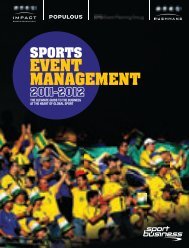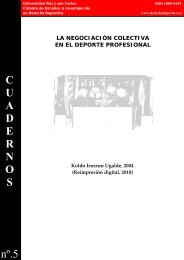4 - FIFA/CIES International University Network
4 - FIFA/CIES International University Network
4 - FIFA/CIES International University Network
Create successful ePaper yourself
Turn your PDF publications into a flip-book with our unique Google optimized e-Paper software.
ANATOMY OF AN EVENT:<br />
WIMBLEDON<br />
Centre Court’s roof, opened in 2009 - Getty Images Sport<br />
Loch Lomond golf tournament in<br />
Scotland. “Any rain delay can cause<br />
a problem but we work around<br />
that,” adds Crump. “We could fly<br />
up to Scotland if required and our<br />
engineers can get the equipment<br />
up and running in two hours if<br />
necessary. But if you give them two<br />
weeks, they will take two weeks.”<br />
A major challenge for both the<br />
All England Club and Creative<br />
occurred in 2006 when the<br />
scoreboards on the Centre and<br />
No.1 Courts had to be changed<br />
to be able to deal with Hawkeye<br />
technology and the now famous<br />
video review system for line calls.<br />
“I thought I was going to get<br />
sackload of letters about it but the<br />
general response to Hawkeye was<br />
unbelievably positive, and when we<br />
did the scoreboard changes they<br />
looked good and the quality was<br />
high, so no-one bothered about it,”<br />
says Ritchie.<br />
Planning never stops<br />
Within the range of suppliers there<br />
are also key relationships. Creative<br />
could not show the range of<br />
information on its screens without<br />
the input of IBM, a multi-national<br />
giant that has developed and<br />
managed IT systems and provided<br />
statistics for the All England Club<br />
and its showpiece since 1990.<br />
“IBM supports a number of<br />
properties and among those are<br />
all the four tennis Grand Slams,”<br />
says Alan Flack, IBM’s Wimbledon<br />
programme executive. “Planning<br />
never really stops, what we learn<br />
from Wimbledon is taken on to<br />
the US Open, but we really kick on<br />
with Wimbledon from the end of<br />
each calendar year.<br />
“Each year there seems to be<br />
subtle, or major, changes in lay-out.<br />
Hawkeye was an innovation that we<br />
had to adapt to and there are always<br />
new statistics coming on stream, but<br />
the great thing about Wimbledon<br />
is that they have long-term<br />
relationships. There is not much<br />
chopping and changing each year.<br />
“We bring the kit in straight<br />
from Roland Garros. The main<br />
infrastructure which drives the<br />
IBM systems is in the US but<br />
there are local servers and scoring<br />
servers which need to be installed.<br />
“We have 100-120 people on site<br />
during the Championships, largely<br />
made up of technicians, statistical<br />
experts and data collectors (who<br />
are all at least county-level tennis<br />
players or above).”<br />
Flack confirms Ritchie and his<br />
team are keen for innovation to be<br />
given its head: “The All England<br />
Club looks to IBM to be at the<br />
forefront of technology and I<br />
think we have proved that over<br />
the years. In the 1990s we<br />
created the first website<br />
shop and now we<br />
have the award-winning IBM Seer,<br />
the world’s first augmented reality<br />
app using live data feeds.”<br />
The Seer allows a smartphone<br />
with a compass to show the user<br />
what is happening around the<br />
complex. It offers information on<br />
queue lengths, where food and<br />
drink stands are located and can<br />
also be held 500 metres from<br />
Centre Court, asks if the user<br />
wants to be able to see what’s<br />
happening inside and can then<br />
stream live video.<br />
“It’s all about added value and it<br />
will now become a core part of our<br />
offering. It has really caught the<br />
imagination,” adds Flack. “People<br />
ask me if IBM would ever want to<br />
cut Wimbledon from its portfolio,<br />
and I always say no. It’s a great<br />
showcase and allows us to take a<br />
lot of clients behind the scenes to<br />
show them our ‘wow’ technology.”<br />
IBM and Creative work in<br />
partnership with the BBC, the UK<br />
public-service broadcaster that has<br />
been showing Wimbledon since<br />
1927. Their cameras have seen most<br />
things but no-one was prepared<br />
for this year’s world record match<br />
between John Isner and Nicolas<br />
Mahut: Ritchie allowed the BBC to<br />
interview the exhausted duo on court<br />
at the end of the 11-hour contest,<br />
breaking the normal practice for<br />
matches outside of the finals.<br />
“We always try to accommodate<br />
broadcasters. If, for instance, NHK<br />
Japan wanted to show a Japanese<br />
player at a time and on a court that<br />
will help their coverage we would<br />
try to do that,” Ritchie reveals.<br />
“There is a huge benefit to us of<br />
being broadcast on a station such<br />
as NHK, so we want to help them<br />
because it helps us.”<br />
Japan is one of the countries<br />
where the All England Club has<br />
licensees who sell tennis-related<br />
equipment and luxury products, so<br />
exposure on a national broadcaster<br />
is good business. Broadcasting<br />
rights are also the biggest<br />
constituent of the Club’s income.<br />
Ritchie’s numerous tasks<br />
during the year include upholding<br />
the great traditions of Wimbledon<br />
- white clothing for the players<br />
(he personally approves each<br />
new design sent in by the<br />
manufacturers) and ensuring the<br />
ground staff have what is<br />
66 SportBusiness <strong>International</strong> • No. 160 • 09.10

















